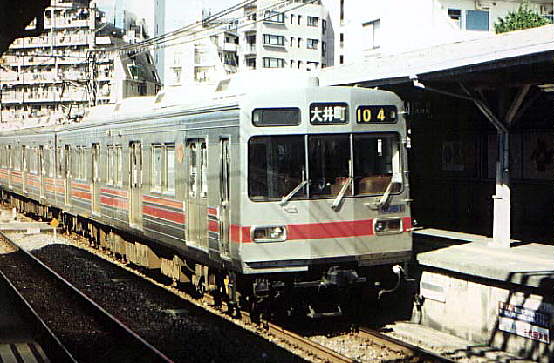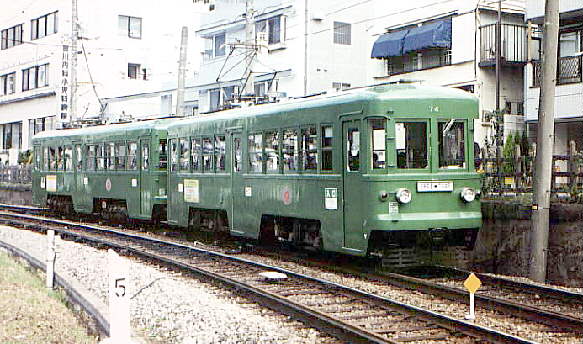
Click here: to see the Tokyu Rail Map.
Toyoko-sen:
The Toyoko-sen (sen means "line") is Tokyu's most important line,
running from Shibuya (one of the big subcenters of Tokyo) to
Sakuragicho in Yokohama. It was opened between Tamagawaen and Yokohama
(15.1 km) in 1926 and between Tamagawaen and Shibuya (9.1 km) in 1927,
and was extended to Takashimacho in 1928 (0.8 km) and to the terminus
Sakuragicho in 1932 (1.3 km). The line is 26.3 km long, has 23
stations, and local trains take 45 min to cover the whole line,
kyuko-(express ) trains 35 min. 1.1 million passengers travel on the
Toyoko-sen each day. It is not only a line for commuters, but also a
non-JR-connection between Tokyo and Yokohama, and a very cheap one. If
you want to go from Shinjuku to Yokohama all the way by JR via
Shinagawa, you have to pay 530 Yen. If you take the Yamanote-sen from
Shinjuku to Shibuya and then change to the Toyoko-sen, you only have to
pay 410 Yen (150 Yen JR plus 260 Yen Tokyu).
8-car-trains are are allocated to the Toyoko-sen, and all trains run over the whole line (except for those coming from or going to the depot at Motosumiyoshi). The service pattern during daytime is two local trains followed by one express train every 15 minutes. But the expresses on this line are so slow because of the many stops, that one of the local trains is not being overtaken, the other one is wating for the express at Hiyoshi. In the rush-hour there is an express every 10 minutes with 3 local trains in between, and then every local train is overtaken at least once. Stations for overtaking are Kikuna, Hiyoshi and Jiyugaoka. Besides these trains, about every third subway train from the Hibiya-sen, that ends at Naka-Meguro, goes on over the Toyoko-sen to Hiyoshi (or to Kikuna during the rush hour). While the normal Tokyu-cars on this line are 20 meters long and have 4 doors, the cars for the Hibiya-sen are slightly different; they are only 18 meters long and have 3 doors. Tokyu's 1000 series and Eidan's 05 series (some of which have 5-door-cars at both ends of the train) can be seen on this service.
Shin-Tamagawa-sen and Denentoshi-sen:
Shin-Tamagawa-sen and Denentoshi-sen are the two newest Tokyu-lines,
but they have become the second and third most important lines now. The
Shin-Tamagawa-sen starts from Shibuya, but from the underground
station, quite far away from the terminus of the Toyoko-sen. The reason
for this is, that all trains from the subway Hanzomon-sen continue on
the Shin-Tamagawa-sen. This line is 9.4 km long with 7 stations and was
opened in 1977, 640,000 passengers travel on it every day now. It
replaced a tramway on this route that was closed in 1969, and is now
running completely underground. At Futako-Tamagawaen, again all trains
continue onto the next line, the Den entoshi-sen. While the part
between Futako-Tamagawaen and Musashi-Mizonokuchi had already opened in
1943 as part of the Oimachi-sen (see below), the Den entoshi-sen was
built in the 1960s as the catalyst for the development of the new
residential area around this line, to be developed by Tokyu. It was
opened to Nagatsuta in 1966 with a length of 14.2 km and the next
opening dates were Nagatsuta - Tsukushino (2.1 km) in 1968, Tsukushino
- Suzukakedai (1.2 km) in 1972, Suzukakedai - Tsukimino (2.3 km) in
1976 and Tsukimino - Chuo-Rinkan (1.2 km) in 1983. Today the Den
entoshi-sen is 22.1 km long and 718,000 passengers use the 20 stations
every day.
As mentioned above, Hanzomon-sen, Shin-Tamagawa-sen and Den entoshi-sen form just one line because all trains operate over all three lines. Local trains from Shibuya to Chuo-Rinkan take 51 min, faster trains run only as far as Nagatsuta (local trains take 40 min to get there): rapid trains (kaisoku) make 11 stops and take 32 min, and express trains (kyuko) make 7 stops, 30 min. The daytime service-pattern is 8 local and 2 rapid trains per hour, but before 9 a.m. and after 4 p.m. there are express trains but no rapid trains. In the busiest hours of the morning, there are up to 26 trains, of which 10 are expresses. All trains have 10 cars, and again you can see Eidan subway cars together with Tokyu cars, this time with the Eidan 8000 series for the Hanzomon-sen.
Kodomo-no-kuni-sen:
The Kodomo-no-kuni-sen is just a 3.4 km
long branch line from Nagatsuta (on the Denentoshi-sen) to
Kodomo-no-kuni ("Children s land"), a big amusement-park. The line
opened in 1967 at the same time as the park, which is operated by
Tokyu. 1400 passengers use it per day, and the trains (2 cars long and
operated by one man only) run between 8 a.m. and 6 p.m.
Oimachi-sen:
The Oimachi-sen was opened between Oimachi,
where it connects with JR s Keihin-Tohoku-sen, and Ookayama (4.8 km) in
1927, and extended further 5.6 km to Futako-Tamagawaen in 1929. The
extension from there to Mizonokuchi (opened in 1943), where it meets
JR's Nambu-sen (JR's station is called Musashi-Mizonokuchi), is now
part of the Den entoshi-sen. Today the Oimachi-sen is 10.4 km long, has
15 stations and 350,000 passengers per day. Only local trains operate
on this line, which takes 21 min. There are 18 trains in the rush hour
and 8 trains per hour during daytime off-peak hours. All trains have 5
cars.

Mekama-sen:
The Mekama-sen was opened in 1923. It runs 13.1
km from Meguro (on JR s Yamanote-sen) to Kamata (JR s
Keihin-Tohoku-sen) and has 15 stations, and carries 302,000 passengers
per day. Here too, only local trains operate, 4 cars each, and take 26
min to cover the whole line. 18 trains run in the rush hour, but some
of them only between Okusawa and Meguro, and 8 trains per hour run
along the whole line over the day.
Ikegami-sen:
The Ikegami-sen is Tokyu s oldest railway line,
opened between Ikegami and Kamata (on JR's Keihin-Tohoku-sen) in 1922,
and exteded to Gotanda in 1928, where it connects with the
Yamanote-sen. It is shorter than the Mekama-sen, only 10.9 km, but also
has 15 stations, that are sometimes no further away than 600 meters
from each other. The Ikegami-sen has some small underground sections
nowadays, so that Tokyu can make use of the new space created above
ground by the removal of track. There are Tokyu stores over some of the
underground stations, e.g. at Nagahara. Only 3-car local trains operate
on this line taking a total of 23 min to cover the whole line, which
223,000 passengers use per day. In the rush hour there are 21 trains,
but every second train runs only between Gotanda and Yukigaya-Otsuka.
During the day there are 8 trains per hour, serving the whole line.
Gauge and Electrification:
All the above mentioned lines are
1067 mm gauge and have been classified as "railways" since the
beginning. Their voltage was originally 600 VDC, but this was converted
to 1500 VDC after the war: Toyoko-sen in 1952, Mekama-sen in 1955,
Ikegami-sen in 1957 and Oimachi-sen in 1958. Shin-Tamagawa-sen and Den
entoshi-sen have been using 1500 V from the beginning.
Tokyu Tramway:
The Setagaya-sen is the last survivor of the
Tokyu tramway network, that consited of three lines until 1969. Today,
only the section from Sangenjaya (at the Shin-Tamagawa-sen) to
Shimotakaido (connection to the Keio-sen), which is 5.1 km long and has
10 stations, and is served in 16 min. The Setagaya-sen is different
from the rest of the network in many ways: It is not included in the
Tokyu fare system, and so there is a flat fare of 130 Yen. The trains
still use 600 V and their gauge is 1372 mm, as on all trams in Tokyo.
53,000 passengers use the line every day. It is in a good condition,
compared to many other trams in Japan, but as trams in Japan are not
allowed to run more than 40 km/h, not much can be done to make the
trams faster. There is no rail connection to any other railway. The
stations have low platforms, so that you have to climb up into the
cars. All cars are coupled to two-car-trains, and the drivers and
conductors collect the fare when you get into the car.

The Tamagawa Denki Tetsudo opened the first tramway in today's Tokyu area in 1907: The line between Shibuya and Futako-Tamagawaen was 9.1 km long and took exactly the same route, that the Shin-Tamagawa-sen (shin means new) uses today. The gauge of this line was 1067 mm, but to transport gravel from the Tama River into the city, it was regauged in 1920 to 1372 mm to enable through-running with the city-owned tram system. This connection was closed in 1938 with the opening of the subway Ginza-sen, but the gauge of 1372 mm remained the standard size for the trams. Three branch lines were opened later: in 1924 from Futako-Tamagawaen northwards to Kinuta-Honmura (Kinuta-sen, 2.2 km, all single track), in 1925 from Sangenjaya to Shimo-Takaido (today s Setagaya-sen, 5.1 km), and in 1927 from Futako-Tamagawaen to Mizonokuchi. The line to Mizonokuchi was regauged to 1067 mm and classified as a "railway" in 1943 and became part of the Oimachi-sen. The Tamagawa-sen and the Kinuta-sen closed in 1969, and the former being replaced by the Shin-Tamagawa-sen in 1977, the latter being served by buses now.